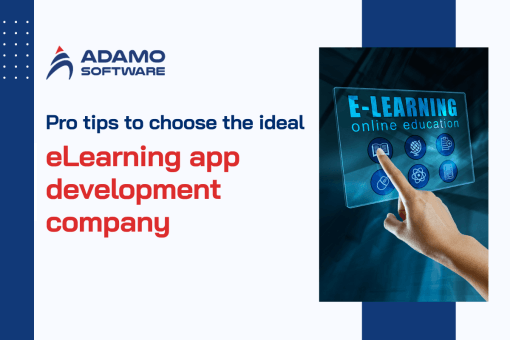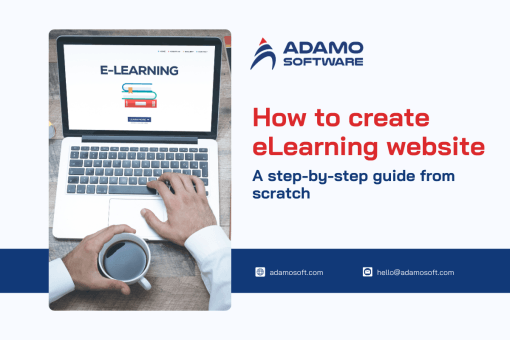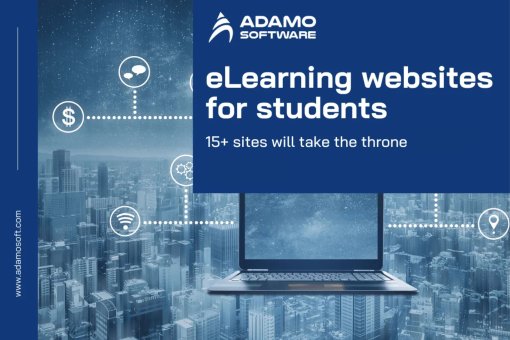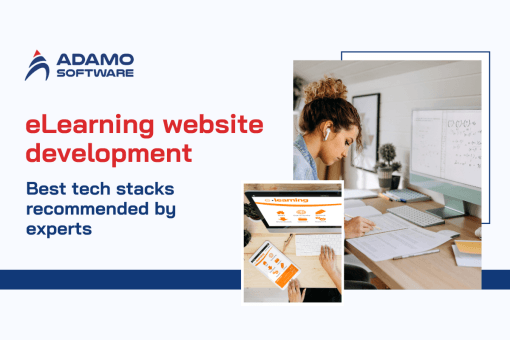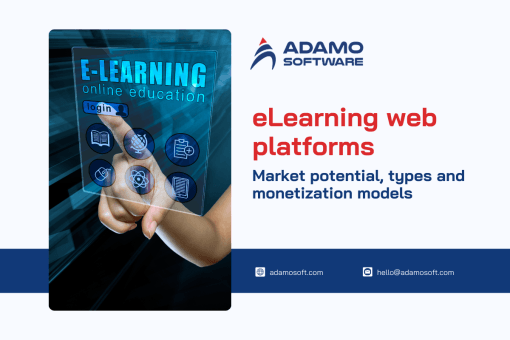
Have you noticed how AI is transforming the education sector in extraordinary ways?
Recent reports indicate that by 2027, the AI education market will surpass $20 billion. Edtech companies now offer AI-generated courses for learners of all ages, providing personalized learning experiences, identifying individual needs, and delivering tailored feedback through e-learning solutions. So, AI development services create software and tools that reshape the entire learning landscape.
This article will be an invaluable resource for startups, entrepreneurs, healthcare providers, and educational institutions aiming to enhance their operations through AI for greater efficiency and innovation. Let’s explore the top 20 AI in education examples to watch for in 2026.
I. Potential Benefits of AI Applications in Education
The potential benefits of AI applications in education are vast and transformative, with 99.4% of the 509 higher education institutions in the United States recognizing its importance for competitiveness in the next three years. In a world where technology is rapidly evolving, AI is making a significant impact in the classroom by providing personalized learning experiences, automating administrative tasks, and enhancing capabilities, the market is expected to exceed USD 20 billion by 2027.
For example, platforms like Carnegie Learning use AI to adapt lessons in real-time, provide tailored feedback, and adjust difficulty levels based on individual student performance. AI-powered tutoring systems, such as those made by Content Technologies development, provide personalized support outside the classroom, identify knowledge gaps, and provide targeted assignments.
Real-life examples show the impact of AI, such as Stanford’s AI program providing 80% accurate recommendations to support students and a University of Murcia chatbot answering more than 38,708 queries accuracy 91% accuracy. Knewton’s AI-based adaptive learning tools increased test scores by 62%, while smart tutoring systems improved scores by 30% and reduced anxiety by 20%.
Additionally, AI tools can automate administrative tasks, allowing educators to focus more on teaching and making education more accessible to students with disabilities through tools like Translating Microsoft presentations. AI also creates more engaging and interactive learning experiences using VR and AR and provides data-driven insights to help educators identify at-risk students of risk and adjust their teaching strategies.
These potential benefits show how AI is revolutionizing education, making it more personalized, effective, and comprehensive. For more detailed examples and case studies of AI in education, explore the resources on Bernard Marr and Axon Park’s websites.
II. Types of AI Used in Education
Applying AI in education not only changes the way students learn, its also helps reshape the roles of educators, managers, and parents.
These are some important AI used in education.
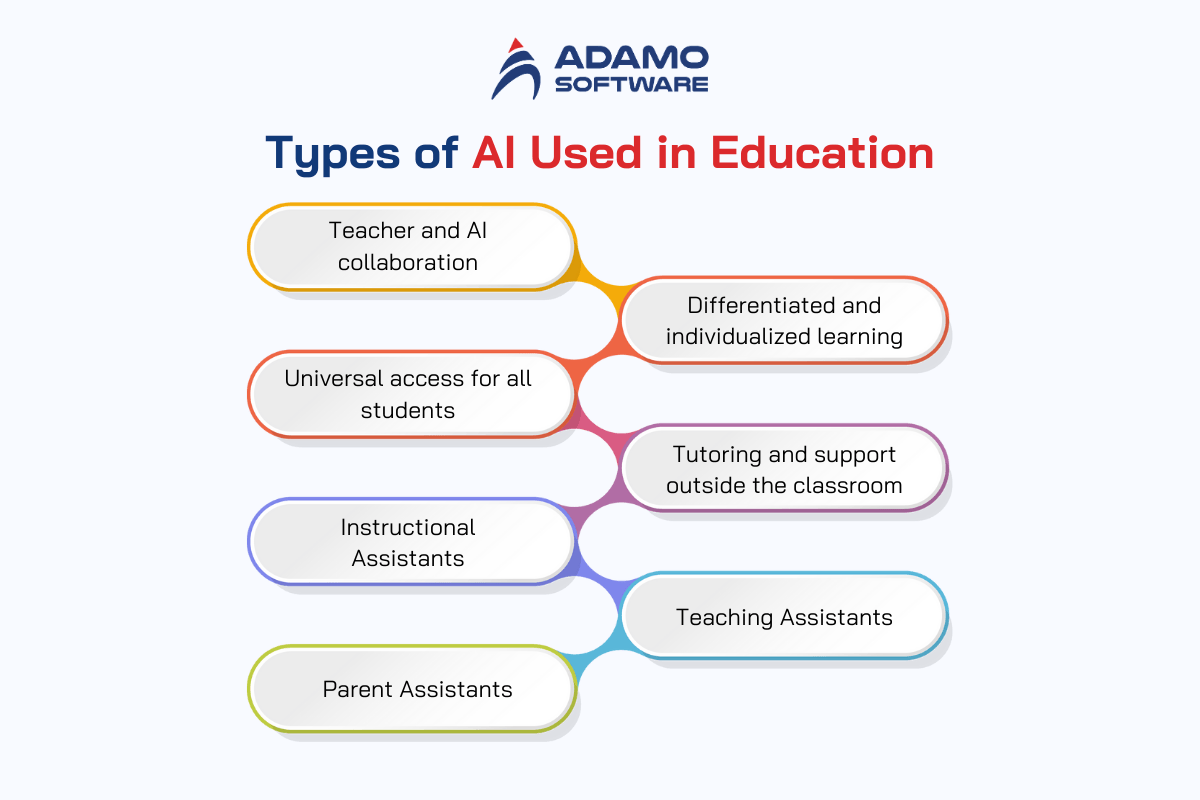
1. Teacher and AI collaboration
One use of AI in education is its application to skill development tools and testing systems. As AI education solutions continue to develop in the future, it will help fill the gaps that still exist in learning and teaching, allowing schools to improve the quality of teaching more effectively. The application of AI in education can personalize and streamline administrative tasks to allow teachers to save a lot of time and adapt to changes that would be difficult for machines. By leveraging the best attributes of AI, teachers can partner with it to deliver the best outcomes for students.
2. Differentiated and individualized learning
Another use of AI in education is to tailor learning activities based on each student’s specific needs. This has been a top priority for educators for many years. AI can enable a level of differentiation that is not possible for teachers managing more than 30 students per class.
For example, companies such as Content Technologies and Carnegie Learning are using AI to develop smart instructional designs and digital platforms to provide learning, testing, and feedback to students from the preschool level to the university level. This makes it possible for students to recognize difficulties and identify gaps in knowledge to move on to appropriate new topics.
When it gets more complicated, AI can read the expressions on students’ faces to know if they are having difficulty grasping a topic and will modify the lesson accordingly to accommodate that.
3. Universal access for all students
The use of AI in education allows for the provision of global classes to everyone, whether they speak different languages or are visually or hearing impaired. For example, Presentation Translator is a free plug-in for PowerPoint software that enables real-time subtitles for teacher speech. This will open up many good opportunities for students who cannot go to school due to illness, or economic conditions, or students who need to study at a different level or even study subjects that are not available at their school. Therefore, AI is a great solution to help break down barriers between schools and traditional grade levels.
4. Tutoring and support outside the classroom
Many students find it difficult to learn algebra, and AI will be a powerful tool in assisting them when they have difficulties with homework or test preparation. Tutoring and academic support programs outside the classroom are becoming more advanced thanks to artificial intelligence, and they will soon be more refined and capable of catering to learning styles.
5. Instructional Assistants
AI tutors are changing the way teachers teach and support students. These AI assistants help educators with tasks such as creating customized learning materials, grading assignments, and providing real-time feedback. In addition, administrative tasks are also automated to give teachers more time to customize teaching materials.
6. Teaching Assistants
AI tutors are changing the way teachers teach and support students. These AI assistants help educators with tasks such as creating customized learning materials, grading assignments, and providing real-time feedback. In addition, administrative tasks are also automated to give teachers more time to customize teaching materials.
7. Parent Assistants
Besides the great benefits for educators, AI also provides support for parents, such as creating letters requesting individual education plan (IEP) services. They can also ask the AI to evaluate their child through a gifted and talented program. In addition, if they want to search for a school for their child, AI will outline school options based on distance, tuition, teaching quality,…
Ready to Outsource?
Get top-tier IT talent without the hassle. Contact us now!
III. Examples of AI in Education (2026 Edition)
1. Mainstay
The mainstay is Ai in education examples, it focuses on success coaching solutions for college students, including AI Chatbots to proactively engage students and provide personalized support through messages. Many colleges and universities partner with Mainstay and see great results such as increased student applications and improved retention rates. This saves a significant number of employees working hours.
2. Course Hero
An Ai in education examples is Course Hero. Online education company Course Hero offers a platform that allows students to access course-specific resources to improve their comprehension and retention of content in various subjects. This online learning platform includes an AI course assistant that uses natural language processing to answer questions and provide the best explanations and recommendations.
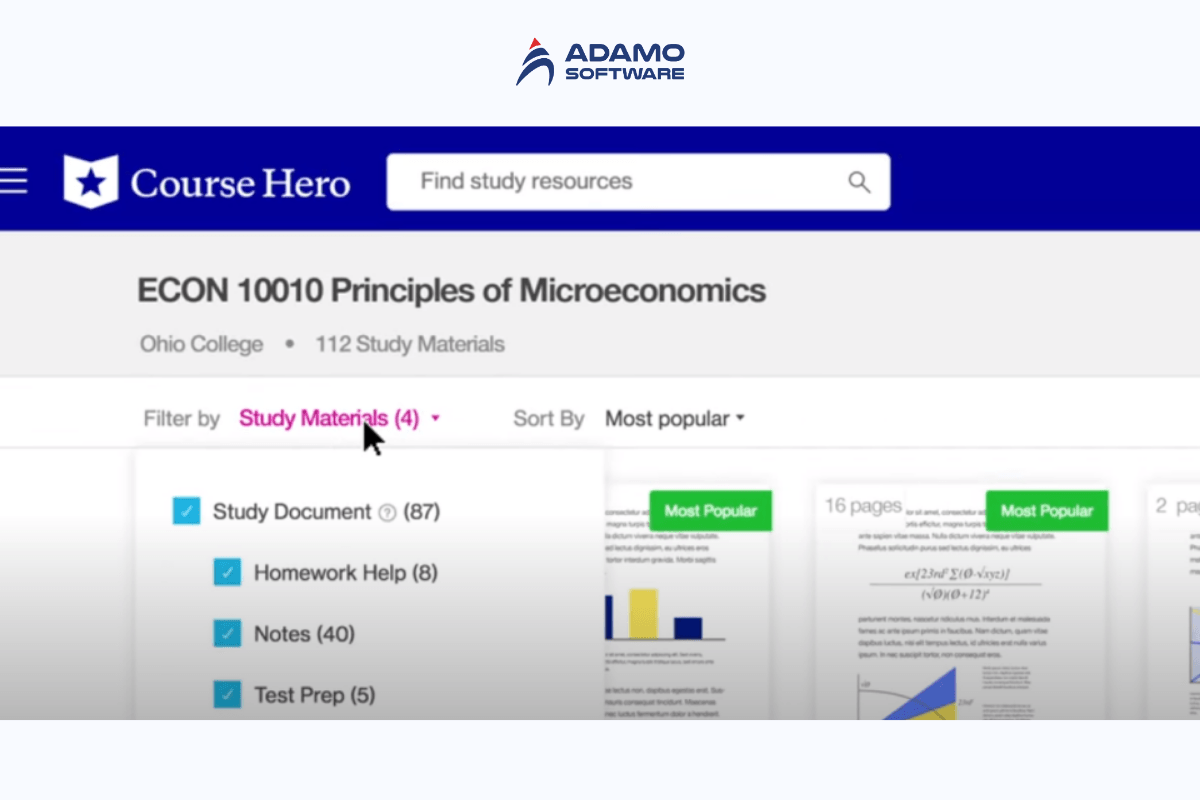
3. 360Learning
As an Ai in education examples, 360Learning brings AI tools into its software platform for employees to learn and grow. For example, employers can use 360 Learning’s authoring tools to create courses for their employees using AI-powered recommendations for content and custom quizzes. The company’s other solutions also include AI-integrated tools to identify and address employee skills and knowledge gaps.
4. Skillsoft
Skillsoft is an Ai in education examples that brings businesses across various industries to train employees and develop skills. Its Percipio platform uses AI to provide personalized recommendations for courses and other learning experiences. Skillsoft also offers a conversational AI simulator called CAISY that allows users to practice their business communication skills.
5. Blueprint Test Prep
Blueprint Test Prep is an Ai in education examples. It is a digital learning platform for studying and preparing for exams like the MCAT and LSAT. For the critical reasoning and analysis portion of the MCAT, Blueprint built and deployed an AI tutor. It operates 24/7 and is designed to meet each student’s unique training needs. The company also offers AI-powered question banks to curate questions and provide study guidance based on students’ strengths and weaknesses.
6. Age of Learning, Inc
Age of Learning is an Ai in education examples providing basic subjects to students in kindergarten through 2nd grade. Additionally, with AI-driven entertaining interactions the company can create learning paths that are engaging, fun, and personalized depending on each student’s skills.
7. Duolingo
Duolingo’s language learning app is an Ai in education examples that offers listening, reading, and speaking exercises for more than 40 languages globally. By applying AI, lessons will be adjusted to each student’s level and level according to their abilities. Duolingo offers a classroom version for schools, as well as a math education app called Duolingo Math.
8. Nuance
Nuance is an Ai in education examples that creates speech recognition software used by students and faculty to transcribe up to 160 words per minute. This technology is especially useful for students who have difficulty writing or have limited ability to manipulate. It also enhances spelling and pronunciation. Instructors use the software to prepare lectures for later use or to quickly perform tasks such as creating documents and emails.
9. Amira Learning
Amira Learning is an example of an AI in education virtual learning application created to accelerate students’ reading comprehension. Using AI technology, Amira asks students to read stories aloud and can assess reading fluency and identify areas for improvement. For teachers and parents, Amira also provides services such as student progress reporting and improving the risk of dyslexia.
10. Blippar
Blippar is an Ai in education examples. Its products enhance the learning efficiency of classroom students by combining computer vision intelligence technology and augmented reality. It also helps integrate interactive materials for topics such as geography, biology, and physics into one visual space. For example, instead of students reading information about an earthquake in a textbook, the system will show them a virtual 3D model of the earthquake process.
11. Blue Canoe
As an Ai in education examples, Blue Canoe is used as a personal teacher and helps students learn English speaking skills. Thanks to voice recognition, students can participate in speaking exercises and receive feedback on how to pronounce the alphabet or a specific sound. Blue Canoe can provide a variety of ways for students to practice at all levels, from beginner to advanced including playing games and chatting.
12. Carnegie Learning
Carnegie Learning is considered an Ai in education examples. It uses AI and machine learning to help students deeply understand and apply concepts in mathematics, as well as the ability to read and write in English and other languages around the world. This platform is mainly for high school and college students. Teachers use responsive AI to study students’ habits and personalize learning experiences to help them fully grasp educational concepts.
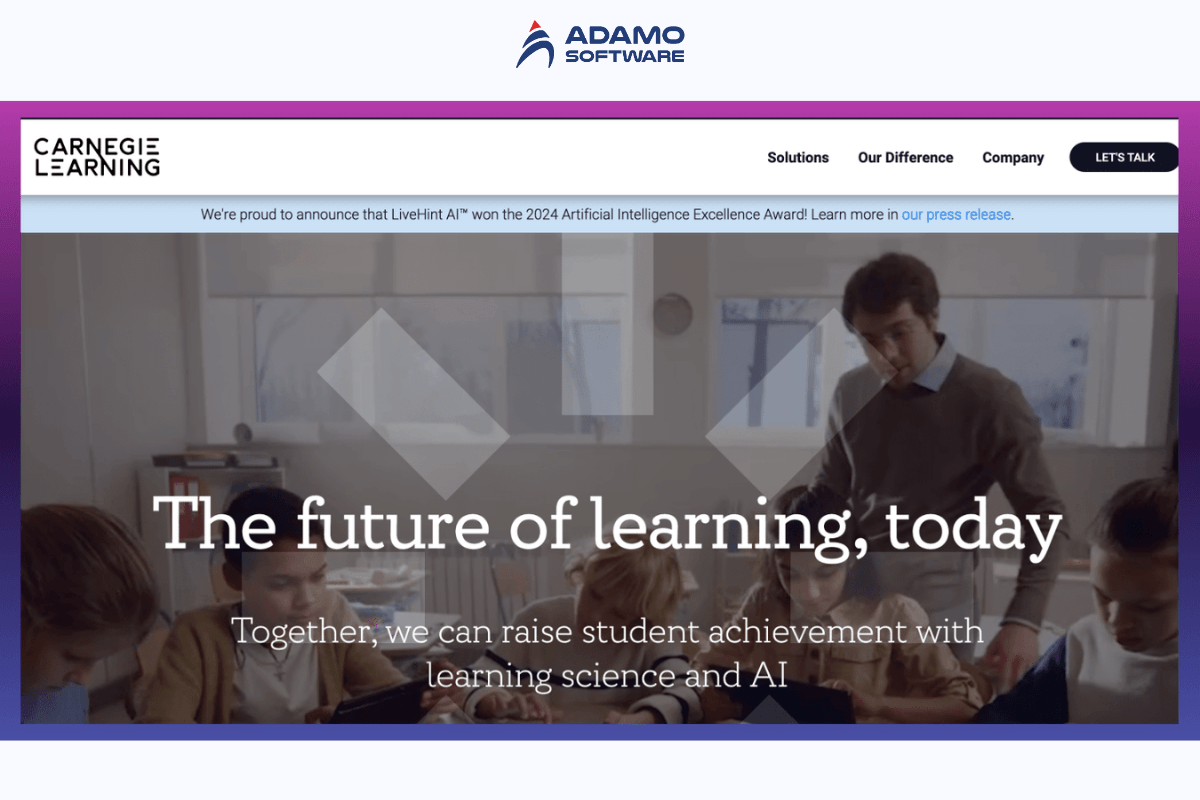
13. Century Tech
Century Tech’s platform is an Ai in education examples. The platform uses cognitive neuroscience and data analytics to create personalized learning plans for students and reduce the workload for educators. It uses AI to track students’ learning progress and identify gaps in their knowledge to make appropriate suggestions to students. Century Tech also helps teachers access valuable resources and save time in planning, grading, and managing students’ homework.
14. Cognii
Cognii creates AI-powered products for higher education and K-12 institutions as well as enterprise training organizations. Students can use the virtual learning assistant’s conversational technology to find open-ended response guidance to improve critical thinking skills. The assistant also allows for real-time feedback, individual student tutoring, and customization to each student’s unique needs.
15. Kidaptive, Inc
As an example of Ai in education, Kidaptive’s Adaptive Learning Platform (ALP) enables educational institutions to collect data and engage learners based on AI algorithms. This ALP platform also uses AI to optimally introduce, and challenge students based on their strengths and weaknesses. The platform also helps students predict future learning outcomes based on underlying patterns and relationships.
16. Knewton
Knewton is an Ai in education examples that creates adaptive learning technology for higher education. It has a program called Alta that identifies gaps in students’ knowledge and offers tailored courses to improve that knowledge. Additionally, Alta is also an aid for those teaching at different levels of education and is mainly used for subjects like biology, mathematics, psychology, etc.
17. Querium Corporation
As an Ai in education examples, Querium uses AI and machine learning to provide customizable STEM tutoring lessons to students at the high school and college levels. Querium’s AI-powered tool also provides teachers with insights into student study habits and identifies areas where students need improvement through analysis of responses and gaps. STEM time to complete tutoring sessions.
18. Quizlet
Quizlet is considered a prominent Ai in education examples and is an online destination for learning tools. In 2017, the company launched the Quizlet Learn platform, an intelligent learning resource that provides plans to adapt the curriculum and help students take the guesswork out of what they will learn. This platform uses machine learning and data from millions of study sessions to select and provide students with the most suitable study material for their studies.

19. Riiid Labs
Riiid Labs is a subsidiary of Riiid, it is also considered an Ai in education examples. It creates AI-based learning and assessment technologies and deploys them into existing applications or as a separate platform. The platform’s machine learning capabilities enable teachers to track student performance and engagement and automate the grading of their homework, personalizing the curriculum needs of each student.
20. Thinkster Math
A final Ai in education example is Thinkster Math. It is a math tutoring program developed for use on laptops, tablets, and desktop computers. This K-12 platform combines AI and human interaction to provide students with programs customized to their learning goals and abilities. This technology will track the performance of activities step by step and help students recognize what they are doing right or spot mistakes so they can improve.
Also read: The Future of Machine Learning in Education: Use Cases and Examples
Ready to Outsource?
Discover how we can transform your business with expert IT solutions.
IV. The Future of Application of AI in Education
Educational technology has become an indispensable part of modern learning, reforming teacher teaching and student learning. As technology continues to evolve, so do trends in education. Teachers must stay informed about emerging trends in educational technology to ensure they provide students with the best learning experiences possible. From artificial intelligence to virtual reality and augmented reality, here are some of the most exciting emerging trends in education technology.
1. Artificial intelligence in education:
Artificial intelligence (AI) is refreshing the education industry by providing personalized learning experiences for students. Using AI-powered content, students can receive appropriate learning materials based on their needs and abilities.
AI-powered virtual teaching assistants are also becoming increasingly popular in educational environments, providing students with a variety of support, guidance, and feedback. Automated grading systems are standardizing the grading process for educators, freeing up valuable time for more personal interactions with students.
Smart, AI-powered content is familiar and interactive, allowing students to learn at their own pace and in a way that suits their learning style. Predictive analytics tools are also being used to identify students at risk of falling behind and provide targeted interventions and support.
2. Virtual and Augmented Reality in Education:
Virtual reality and augmented reality (VR and AR) are transforming the traditional classroom experience by providing immersive learning experiences. With VR and AR, students can take virtual field trips to historical landmarks, explore distant planets, or participate in interactive simulations that make learning more fun.
These technologies provide hands-on training opportunities in all fields, from medicine to engineering, allowing students to practice real-world skills in a safe and controlled environment. Learning environments that incorporate VR and AR also allow students to collaborate on projects and share experiences.
3. Gamification in Education:
Gamification is also a use of AI in education to increase student participation and motivation in classroom activities. Thanks to Gamification, teachers can make learning more fun and interactive by using game elements such as quizzes, challenges, and rewards in the learning process.
Adopting gamified platforms helps students progress at their own pace and ability, as well as receive a customized learning experience. It also provides educators with valuable insights into student performance and engagement, allowing them to review and make data-driven decisions about teaching methods or curriculum. Today, the application of Gamification is becoming popular and provides a more comprehensive view to evaluate student learning and progress.
4. Online and Blended Learning Platforms:
The rise of online and blended learning platforms has transformed the way education is delivered, making learning more accessible and flexible for students of all ages. Interactive online classrooms provide collaborative spaces for students to interact with friends and teachers, anywhere, anytime.
Personalized online learning pathways allow students to work at their own pace and focus on the areas they need the most support. Collaboration tools enable students to work together on projects and assignments, developing a sense of community and teamwork. Integrating artificial intelligence into online learning platforms will enhance personalized learning experiences for students, providing relevant content and support.
5. Big data plays an important role in education:
Big data has become an invaluable educational resource, allowing educators to make data-driven decisions and personalize students’ learning experiences. Personalized learning recommendations powered by big data algorithms help students access resources and materials tailored to their unique learning preferences and styles. Predictive analytics tools allow educators to identify at-risk students
V. Final Thoughts
Shortly, AI will continue to transform the education sector in profound ways. From personalized learning experiences to advanced administrative automation, the examples we have explored highlight the enormous potential of AI to enhance the quality of education.
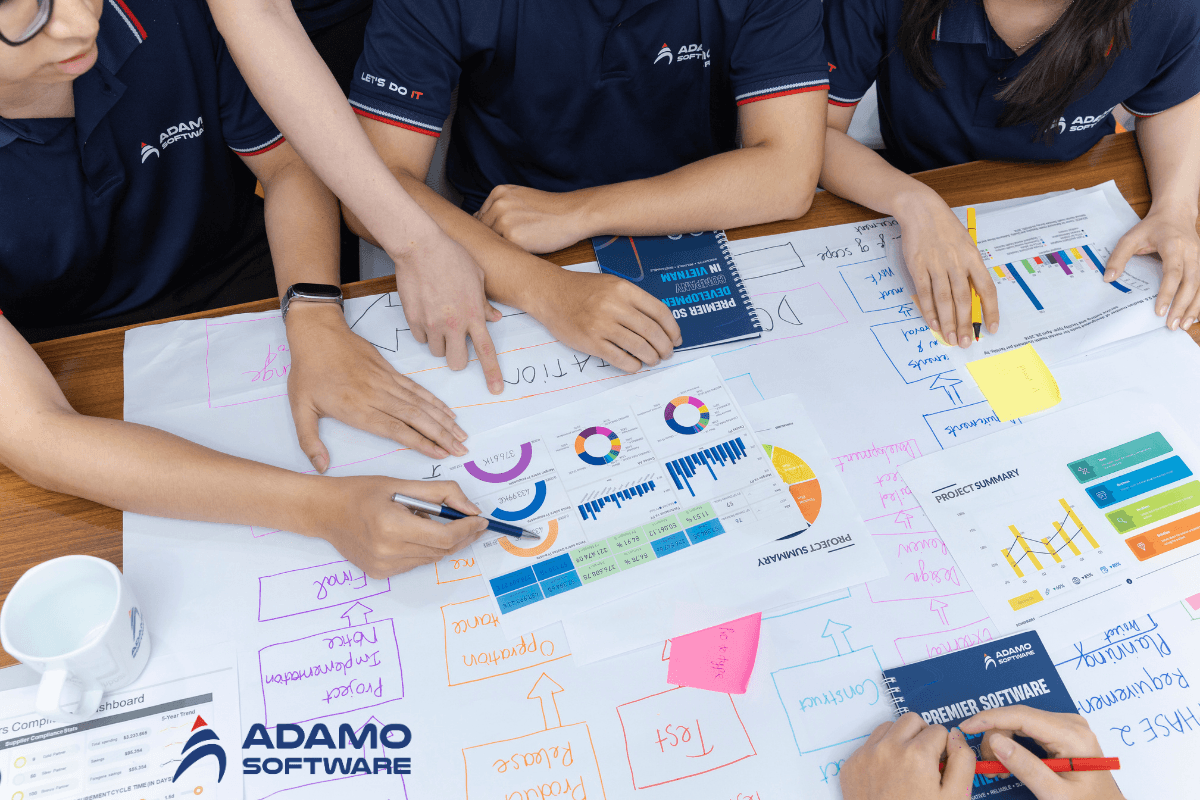
As organizations and educators look to implement these innovative solutions, partnering with leading AI development services like Adamo Software can provide many benefits. We specialize in creating cutting-edge AI tools that not only reshape education but also drive efficiency and innovation across industries, and education is no exception.
If you’re thinking of developing educational apps, let Adamo help you stay ahead of the rapidly evolving education landscape.






